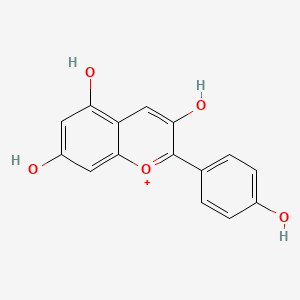| MeSH term | MeSH ID | Detail |
|---|---|---|
| Cystitis | D003556 | 23 associated lipids |
| Parkinsonian Disorders | D020734 | 20 associated lipids |
Pelargonidin
Pelargonidin is a lipid of Polyketides (PK) class. The involved functions are known as Uptake, Intestinal Absorption, glucose uptake, Process and Metabolic Inhibition. Pelargonidin often locates in Serosal, Mucous Membrane, brush border membrane, Membrane and Cell surface. The associated genes with Pelargonidin are SLC5A1 gene, SLC2A2 gene, Homologous Gene, F3 gene and CRSP3 gene. The related experimental models are Knock-out.
Cross Reference
Introduction
To understand associated biological information of Pelargonidin, we collected biological information of abnormalities, associated pathways, cellular/molecular locations, biological functions, related genes/proteins, lipids and common seen animal/experimental models with organized paragraphs from literatures.
What diseases are associated with Pelargonidin?
There are no associated biomedical information in the current reference collection.
Possible diseases from mapped MeSH terms on references
We collected disease MeSH terms mapped to the references associated with Pelargonidin
PubChem Associated disorders and diseases
What pathways are associated with Pelargonidin
There are no associated biomedical information in the current reference collection.
PubChem Biomolecular Interactions and Pathways
Link to PubChem Biomolecular Interactions and PathwaysWhat cellular locations are associated with Pelargonidin?
Visualization in cellular structure
Associated locations are in red color. Not associated locations are in black.
Related references are published most in these journals:
| Location | Cross reference | Weighted score | Related literatures |
|---|
What functions are associated with Pelargonidin?
Related references are published most in these journals:
| Function | Cross reference | Weighted score | Related literatures |
|---|
What lipids are associated with Pelargonidin?
There are no associated biomedical information in the current reference collection.
What genes are associated with Pelargonidin?
Related references are published most in these journals:
| Gene | Cross reference | Weighted score | Related literatures |
|---|
What common seen animal models are associated with Pelargonidin?
Knock-out
Knock-out are used in the study 'MATE2 mediates vacuolar sequestration of flavonoid glycosides and glycoside malonates in Medicago truncatula.' (Zhao J et al., 2011).
Related references are published most in these journals:
| Model | Cross reference | Weighted score | Related literatures |
|---|
NCBI Entrez Crosslinks
All references with Pelargonidin
Download all related citations| Authors | Title | Published | Journal | PubMed Link |
|---|---|---|---|---|
| pmid: | ||||
| Grigoriev SM et al. | Regulation of mitochondrial KATP channel by redox agents. | 1999 | Biochim. Biophys. Acta | pmid:10076019 |
| Giusti MM et al. | Molar absorptivity and color characteristics of acylated and non-acylated pelargonidin-based anthocyanins. | 1999 | J. Agric. Food Chem. | pmid:10552862 |
| Toki K et al. | Anthocyanins from the scarlet flowers of Anemone coronaria. | 2001 | Phytochemistry | pmid:11314957 |
| Dong X et al. | Functional conservation of plant secondary metabolic enzymes revealed by complementation of Arabidopsis flavonoid mutants with maize genes. | 2001 | Plant Physiol. | pmid:11553733 |
| Nyman NA and Kumpulainen JT | Determination of anthocyanidins in berries and red wine by high-performance liquid chromatography. | 2001 | J. Agric. Food Chem. | pmid:11559107 |
| Wang SY and Zheng W | Effect of plant growth temperature on antioxidant capacity in strawberry. | 2001 | J. Agric. Food Chem. | pmid:11600054 |
| Marinov BS et al. | Effects of pelargonidine and a benzocaine analogue p-diethylaminoethyl benzoate on mitochondrial K(ATP) channel. | 2001 | Membr Cell Biol | pmid:11699869 |
| Noda Y et al. | Antioxidant activities of pomegranate fruit extract and its anthocyanidins: delphinidin, cyanidin, and pelargonidin. | 2002 | J. Agric. Food Chem. | pmid:11754562 |
| Seeram NP et al. | Characterization, quantification, and bioactivities of anthocyanins in Cornus species. | 2002 | J. Agric. Food Chem. | pmid:11958615 |
